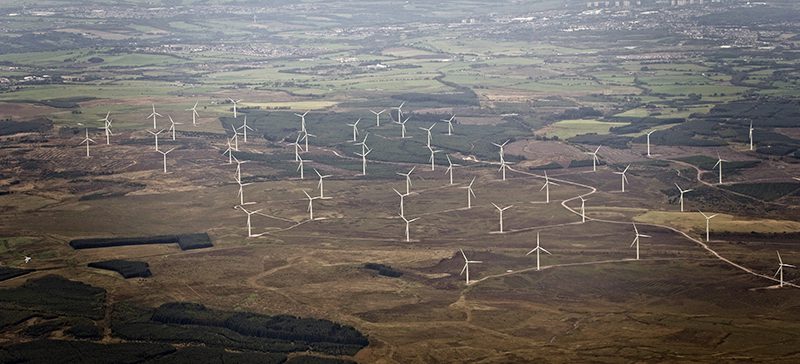
With lowest cost green energy considered the future, understanding how to ‘repower’ existing onshore wind farms supports the Scottish government and industry desire to generate affordable wind power in the future.
Researchers from the Universities of Glasgow and Aberdeen spent more than a year working in close consultation with partners in the private and public sectors to work out how this can be done as sustainably as possible.
Their conclusions, published online on 19 November, represent a comprehensive body of research on what to consider when it comes to replacing Scotland’s wind power infrastructure.
What is repowering?
Wind turbines, and the concrete bases on which they stand, have a limited lifespan. Once they reach the end of their useful life, measures to extend the life of components and turbines at wind farm sites, or replace those components altogether, are known as ‘repowering’.
The majority of onshore wind farms in Scotland are onpeatlands, which are in themselves important environmental resources as they collect and store a huge pool of atmospheric carbon. Windfarm developments on such carbon stores seek to minimise disturbance, including restoration of historically degraded sites, such that carbon lost in development is offset and surpassed by a life of fossil-free energy generation – and so this report pays special attention to repowering on peatlands.
Scotland currently generates a significant amount of electricity from renewable sources – around 60% of the country’s gross annual consumption in 2015, up from just 12% in 2000. Much of that increase is supplied by onshore wind farms.
Generating more energy in the future
In order to achieve the Scottish Government’s goal of generating unsubsidised wind energy, existing wind farms could generate more energy in the future by installing bigger turbines capable of generating more energy per unit of wind speed.
Scotland is currently home to more than 3,200 operational wind turbines, with a further 2,300 either under construction or awaiting planning permission. However, only a handful of wind turbine sites have undergone a repowering process to date, leaving unanswered many important questions about how to minimise use of resources and land disturbance.
The University of Glasgow’s Professor Susan Waldron and the University of Aberdeen’s Professor Jo Smith are the report’s lead authors. Their report was commissioned by the Construction Scotland Innovation Centre.
Prof Waldron, of the University of Glasgow’s School of Geographical and Earth Sciences, said: “Scotland’s wind power generation infrastructure is extensive, and ensuring that the country can reach its sustainable power goals while minimising the environmental impact of repowering needs many different factors to be balanced.
“One of the biggest questions about the repowering process is how feasible it will be to re-use the existing foundations of wind turbine generators, and whether the cost of repowering could still allow subsidy-free generation.
“We worked closely with Arup, SSE, Scottish Natural Heritage, ScottishPower Renewables, and the Scottish Environment Protection Agency to consider the ecological, hydrological, biogeochemical and carbonsecurity impacts of the repowering process.
“We’ve completed the most comprehensive and collaborative report on repowering to date. This showsthat foundations could be re-engineered to take bigger turbines (for another 30 years), but reusing the foundation generally requires more construction materials and disturbs the soil as much as a new foundation.
“This is a research report and not a policy document, but its findings will help policymakers, who will take a long-term view of managing the repowering process to support Scotland’s ambition for wind power generation to be as commercially viable and as sensitively delivered as possible.”
The paper, titled ‘Repowering onshore wind farms: a technical and environmental exploration of foundation reuse’, is published on the Open Science Framework website at https://osf.io/sczde/.






